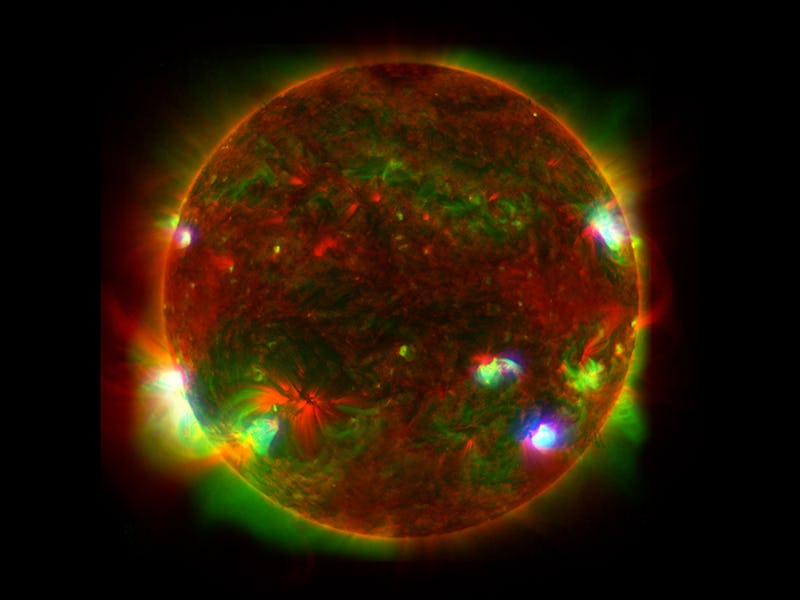NASA Might Finally Solve the Million-Degree Mystery of the Sun's Corona
This vibrant new image of the Sun is a treasure trove of science.

The Sun is full of mysteries. A close look at a new collage of light from NASA might help answer at least one pesky question about our local star.
In a new colored image of the Sun, which NASA released on Thursday, are three shades of colors. The two most obvious are green and red. They portray wavelengths of light the Sun emits across its entire face. But in a few corners are splotches of blue. These represent small events that could be elevating the temperature of the Sun’s outer atmosphere to more than a million degrees.
Up until now, scientists have been baffled by the scorching temperature of this region. It’s called the corona, a word that translates to “crown” in several Latin-based languages. It adorns the Sun like a wispy halo, and is visible during total solar eclipses. But for some unknown reason, the corona is much hotter than the region of the atmosphere underneath it that lies closer to the body of the star.
This image contains information from three missions. Red represents ultraviolet light observations obtained using NASA’s Solar Dynamics Observatory. The small regions of blue represent the high-energy X-rays from the nanoflares, viewed with NASA’s NuSTAR telescope. Green portrays lower-energy X-rays, from Japan’s Hinode mission.
The places colored blue in the NASA image might hold the answer. They represent nanoflares, smaller versions of the star’s spectacular eruptions. Regular flares and nanoflares produce material hotter than the average temperature of the corona, according to NASA. Nanoflares happen much more frequently than regular flares, however. And although they are smaller events, they might be occurring frequently enough to generate the corona’s incredible heat. Regular flares, by contrast, don’t appear as often.
The nanoflares appeared in observations from NASA’s NuSTAR, or Nuclear Spectroscopic Telescope Array. The new image displays their high-energy X-ray emissions in blue and combines information from 25 images taken in June 2022.
The data split into individual images.
The green parts of the image represent lower energy X-ray data from the X-ray Telescope (XRT) on the Japanese Aerospace Exploration Agency (JAXA) Hinode mission. The red regions show ultraviolet light observations from the Atmospheric Imaging Assembly (AIA) of another NASA mission, the Solar Dynamics Observatory.
The Sun is currently approaching the most active part of its 11-year cycle, called the solar maximum. So, expect more spectacular displays and outbursts in the near future.